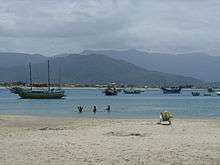Garopaba
Garopaba is a town on the South coast of the state of Santa Catarina in Brazil. Before being discovered by tourists, Garopaba was a small fishing village. During the 1970s, foreigners carrying backpacks and tents discovered this then small fishermen village, and started to lend the city a different air and color. This kicked off changes that led to what today is a city that thanks to an adequate urban land legislation, still keeps the old characteristics of the original village, with one and two-story houses.
Climate is moderate and humid, without a dry season. Summer is hot, with average annual temperature of 18ºC, but reaching peak temperatures close to 40ºC. Winter is mild, with average temperatures of 10ºC.
Get in
By car
- For those coming from the north, take the BR-101 to the south, to the kilometer 272, bending left, access to Araçatuba (there are signposts), and entering the SC 434, continuing for 14 km to the entrance to the city.
- Coming from the south, take the same road, turning right at km 272, continuing the SC 434.
By plane
- Closest airport is in Florianopolis, and then by bus (there are several a day) until Garopaba.
Get around
See
Beaches

- Gamboa Beach. Open sea beach. It has a community dedicated to fishing. In the far north, with difficult access, 15 km through hills.
- Siriú Beach. South of Praia da Gamboa, north of the city. By the sea, near the city of Garopaba, there is a formation of sand dunes, with a length of 5 km, good for sandboarding. The Rio Siriú begins in the beautiful lagoon Macacu, flowing north from the beach. At this site there is a restaurant and inn, being visited by vacationers. There is a dirt road that gives access to the beach from the main road that goes from Garopaba to Paulo Lopes (a small sign indicates the entrance).
- Garopaba Beach. on the edge of the city of Garopaba, in a cove, so the waters are very calm. It's 2 km long, the most urbanized beach. At the south edge of this beach, lies the old city of Garopaba, a fishing village. Going north, there are the beach houses for rent.
- Sloth Beach (praia da Preguiça). Also known as "Prainha", it's a small beach, quiet, located in the Bairro da Vigia (Watch Neighborhood). Next to it is the Grotto of Our Lady of Lourdes. A little later it gets called "Costão", where you can hike on trails and watch the sea in their struggle with the rocky coastline.
- Silveira Beach. Located south of the city of Garopaba. Access is via a dirt road from the paved promenade which gives entry to Garopaba. Next to the store Mormaii. Rich in near-native vegetation, has unique charms. Surrounded by mountains, it is not suitable for bathing, as it has many waves, that are perfect for surfing, practiced intensely. In the southern part ther's a rocky bottom, ensuring a kind of wave much appreciated by surfers.
- Rust Beach (Praia da Ferrugem). It's surf capital. Greenish waters, white sands, endless summer, beautiful girls. The night is lively in its numerous bars. It's 5 km from the city of Garopaba in Capão District. Ferrugem has a channel that separates it from Barra Beach. It was this channel that gave name to the beach because on certain days, when its bottom is full of sand, the waters are more yellowish, suggesting the color of rust. Beautiful sunset.
- Barra Beach (Praia da Barra). Separated from Ferrugem by a small hill by the sea, actually a Sambaqui, which in the past was the Indians Carijós cemetery, much visited by tourists, who walk on it, and enjoy the burst of waves on the rocks. From above it can be seen surfers. On site a creek, that connects a pond to the sea, good for children and adults to bathe in their waters. Later you can surf, enjoying the waves.
- Ombudsman Beach (Praia do Ouvidor). 12 km south of the town of Garopaba, with white sands, dunes and cliffs. There are 800 meters of beach, dunes and surrounded by greenery, among coconut trees and virgin forest. This beach is still wild, without infrastructure.
- Red Beach (Praia Vermelha). Beach without infrastructure with difficult access. -
Do
Blessed by nature with beauty, the city is ideal for eco tourism and the practice of sports such as: surfing, windsurfing, hang gliding, paragliding, trekking and enduro. For those who appreciate lively parties and lively people, there is some fancy meeting "points" along Ferrugem beach.
Buy
Eat
Mid-range
- Setentaesete (77), Av. dos Pescadores, 77, ☎ +55 48 3254-6622. Buffet and alacarte service.
- Gelomel, Av. dos Pescadores, 285, ☎ +55 48 3254-3286. Traditional ice cream parlor.
Splurge
- H2O Sushi Bar, Rua Joao Orestes de Araujo, 893, ☎ +55 48 3254-1183. Sushi, Japanese and seafood.
- Restaurante Zanoni, Rod. SC 434 Km 02, Palhocinha, ☎ +55 48 3254-3391. open all year on weekends, on summer every day, noon-midnight. Steaks and seafood. Parking and WiFi.
Drink
Sleep
- Garopaba Mar Hotel, Rua Nereu Ramos, Morro do Ferraz (700 m from Garopaba beach), ☎ +55 48 3254-3000, e-mail: reservas@garopabamarhotel.com.br. All rooms have air-con, TV, fridge and telephone. from R$ 245/night.
- Pousada Mares do Sul, Av. Francisco Pacheco de Souza, 393, ☎ +55 48 3354-1921, e-mail: reserva@maresdosulpousada.com.br. At the center of Garopaba, 600 m from the sea. 10 suites with nice views to the lagoon, all have fridge, TV, satellite dish, air-con, WiFi, ceiling fan, solar heated water, mosquito net and room service. Beach kiosk, coal grill, parking and breakfast.
- Pousada Ferrujão, Rua Garoupas, 50 - Praia da Ferrugem, ☎ +55 48 3254-0050, e-mail: reservas@pousadaferrujao.com.br. On the beachfront of Ferrugem. Parking, breakfast and restaurant.
Go next
| Routes through Garopaba |
| Criciúma ← Imbituba ← | S |
→ Palhoça → São José |